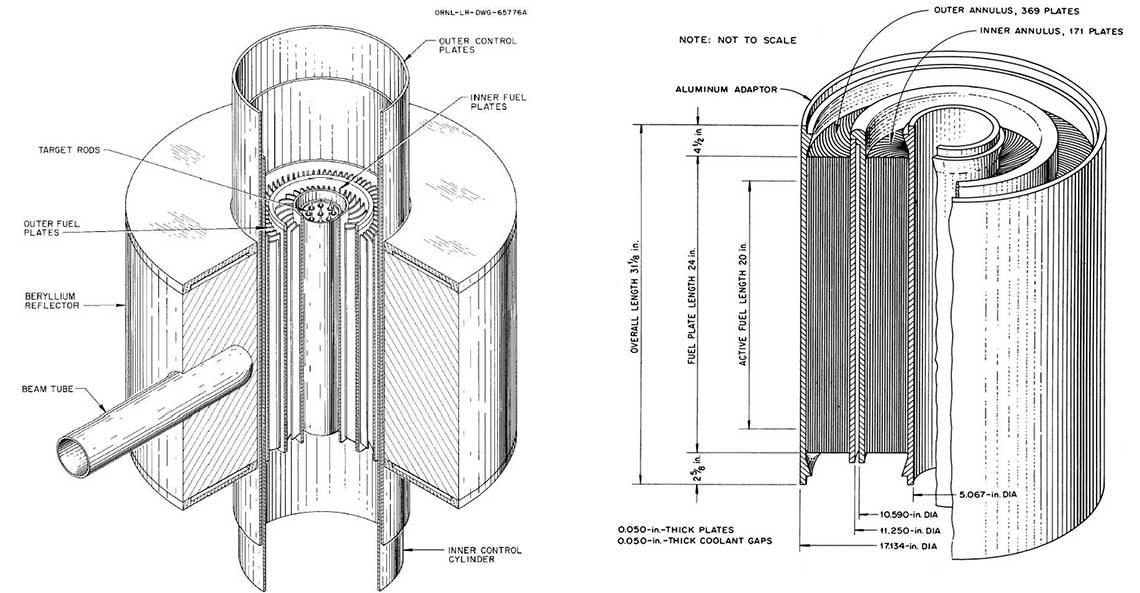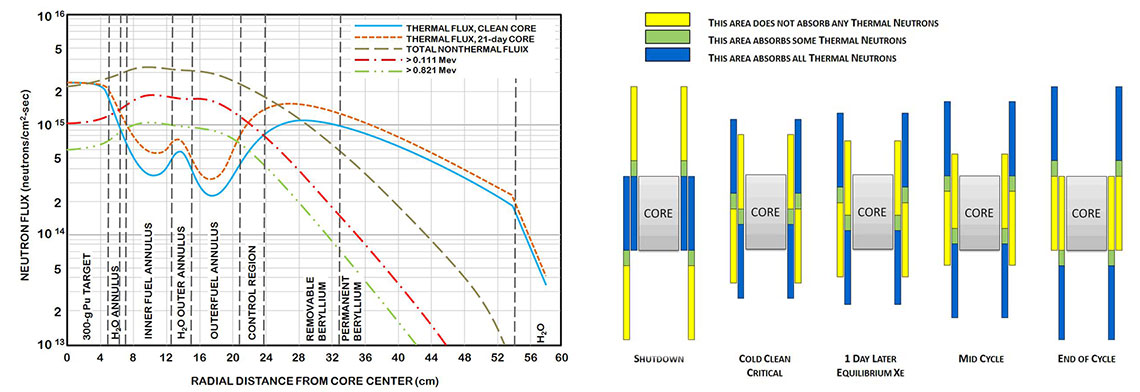High Flux Isotope Reactor Core Assembly
The reactor core assembly is contained in an 8-ft (2.44-m)-diameter pressure vessel located in a pool of water. The top of the pressure vessel is 17 ft (5.18 m) below the pool surface, and the reactor horizontal mid-plane is 27.5 ft (8.38 m) below the pool surface. The control plate drive mechanisms are located in a subpile room beneath the pressure vessel. These features provide the necessary shielding for working above the reactor core and greatly facilitate access to the pressure vessel, core, and reflector regions.
The reactor core is cylindrical, approximately 2 ft (0.61 m) high and 15 inches in diameter. A 5-in. (12.70-cm)-diameter hole, referred to as the "flux trap," forms the center of the core. The target typically contains curium-244 and other transplutonium isotopes and is positioned on the reactor vertical axis within the flux trap. The fuel region is composed of two concentric fuel elements. The inner element contains 171 fuel plates, and the outer element contains 369 fuel plates. The fuel plates are curved in the shape of an involute, thus providing a constant coolant channel width. The fuel (U 3O 8-Al cermet) is non-uniformly distributed along the arc of the involute to minimize the radial peak-to-average power density ratio. A burnable poison (boron-10) is included in the inner fuel element primarily to flatten the radial flux peak providing a longer cycle for each fuel element. The average core lifetime with typical experiment loading is approximately 23 days at 85 MW.
The fuel region is surrounded by a concentric ring of beryllium reflector approximately 1 ft (0.30 m) thick. This in turn is subdivided into three regions: the removable reflector, the semipermanent reflector, and the permanent reflector. The beryllium is surrounded by a water reflector of effectively infinite thickness. In the axial direction, the reactor is reflected by water.
The control plates, in the form of two thin, poison-bearing concentric cylinders, are located in an annular region between the outer fuel element and the beryllium reflector. These plates are driven in opposite directions to open and close a window at the core mid-plane. Reactivity is increased by downward motion of the inner cylinder and the upward motion of the four outer quadrant plates. The inner cylinder is used for shimming and power regulation and has no fast safety function. The outer control cylinder consists of four separate quadrant plates, each having an independent drive and safety release mechanism. All control plates have three axial regions of different neutron poison content designed to minimize the axial peak-to-average power-density ratio throughout the core lifetime. Any single quadrant plate or cylinder is capable of shutting the reactor down.

Cutaway views of the beryllium reflector (left), and the fuel element (right).
The reactor instrumentation and control system design reflects the emphasis placed on the importance of continuity of operation while maintaining safe operation. Three independent safety channels are arranged in a coincidence system that requires agreement of two of the three for safety shutdowns. This feature is complemented by an extensive "on-line" testing system that permits the safety function of any one channel to be tested at any time during operation. Additionally, three independent automatic control channels are arrayed so that failure of a single channel will not significantly disturb operation. All of these factors contribute to the continuity of operation of the HFIR.
The primary coolant enters the pressure vessel through two 16-in. (40.64-cm)-diameter pipes above the core, passes through the core, and exits through an 18-in. (45.72-cm)-diameter pipe beneath the core. The flow rate is approximately 16,000 gpm (1.01 m³/s), of which approximately 13,000 gpm (0.82 m³/s) flows through the fuel region. The remainder flows through the target, reflector, and control regions. The system is designed to operate at a nominal inlet pressure of 468 psig (3.33 x 106 Pa). Under these conditions the inlet coolant temperature is 120°F (49°C), the corresponding exit temperature is 156°F (69°C), and the pressure drop through the core is about 110 psi (7.58 × 105 Pa).
From the reactor, the coolant flow is distributed to three of four identical heat exchanger and circulation pump combinations, each located in a separate cell adjacent to the reactor and storage pools. Each cell also contains a letdown valve that controls the primary coolant pressure. A secondary coolant system removes heat from the primary system and transfers it to the atmosphere by passing water over a four-cell induced-draft cooling tower.

Neutron flux distributions at the core horizontal midplane with HFIR operating at 85MW (left), HFIR core control plate positions (right).
A fuel cycle for the HFIR normally consists of full-power operation at 85 MW for a period of 21 to 23 days (depending on the experiment and radioisotope load in the reactor), followed by an end-of-cycle outage for refueling. End-of-cycle refueling outages vary as required to allow for control plate replacement, calibrations, maintenance, and inspections. Experiment insertion and removal may be accomplished during any end-of-cycle outage. Interruption of a fuel cycle for experiment installation or removal is strongly discouraged to avoid impact on other experiments and neutron scattering. Deviations from the schedule are infrequent and are usually caused by electrical power outages, reactor and experiment component malfunctions, etc.


